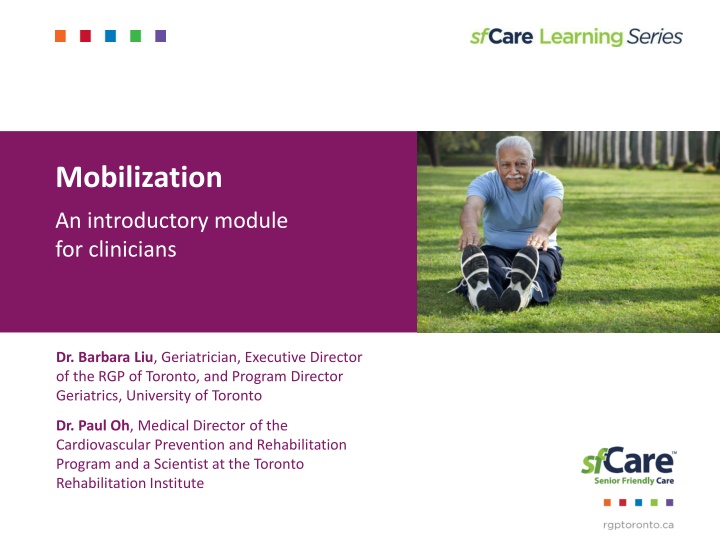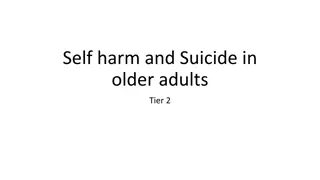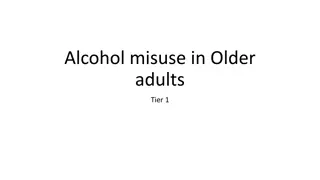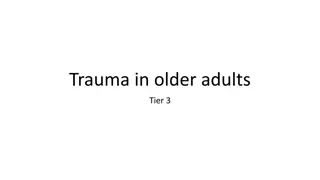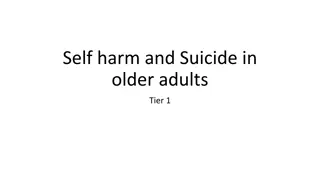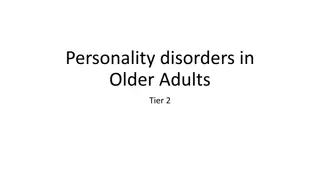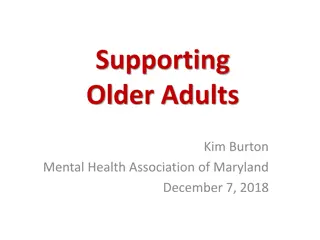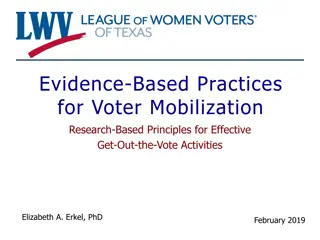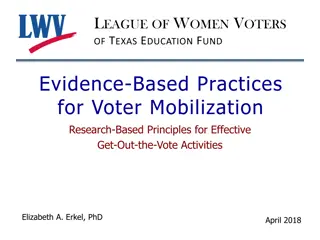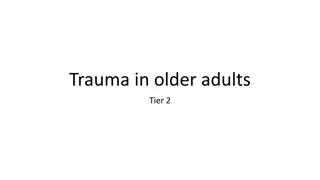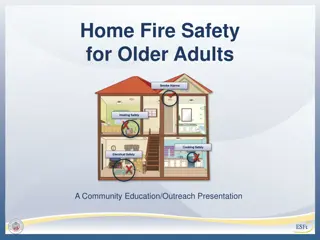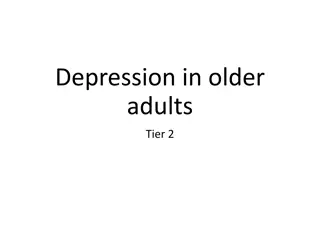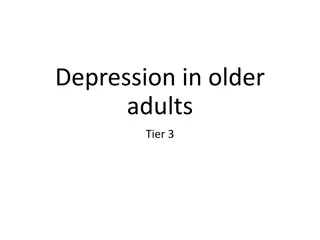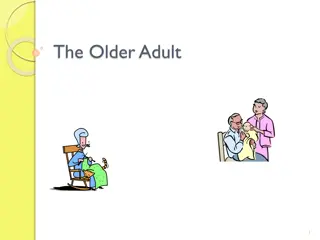Mobilization: Importance, Risks, and Recommendations for Older Adults
Encouraging mobilization in older adults is crucial to counteract muscle loss and avoid negative health consequences associated with immobility. This module highlights the impacts of immobility, provides recommendations for mobilization based on frailty status, and offers ideas for promoting mobility in older patients through a senior-friendly approach. Hazards of immobility, such as respiratory, circulatory, gastrointestinal, genitourinary, and musculoskeletal complications, further emphasize the importance of staying active in older age.
Download Presentation

Please find below an Image/Link to download the presentation.
The content on the website is provided AS IS for your information and personal use only. It may not be sold, licensed, or shared on other websites without obtaining consent from the author.If you encounter any issues during the download, it is possible that the publisher has removed the file from their server.
You are allowed to download the files provided on this website for personal or commercial use, subject to the condition that they are used lawfully. All files are the property of their respective owners.
The content on the website is provided AS IS for your information and personal use only. It may not be sold, licensed, or shared on other websites without obtaining consent from the author.
E N D
Presentation Transcript
Mobilization An introductory module for clinicians Dr. Barbara Liu, Geriatrician, Executive Director of the RGP of Toronto, and Program Director Geriatrics, University of Toronto Dr. Paul Oh, Medical Director of the Cardiovascular Prevention and Rehabilitation Program and a Scientist at the Toronto Rehabilitation Institute
This module is part of the sfCare approach Patient Handout 8.5 x 11 Poster PowerPoint Presentation 2 2
Objectives Objectives 1. Identify the negative effects that immobility can have on older adults The importance of mobilization 2. Describe mobilization recommendations for non- frail, pre-frail, and frail older adults Recommendations 3. Give examples of mobilization ideas that you can recommend for your older adult patients Mobilization ideas Summary 4. Apply a senior-friendly approach to mobility Senior friendly approach Questions 3
Importance of mobilization We lose muscle mass as we age, and immobility compounds the effect of age Objectives Each day, older patients without mobilization lose 1 to 5% of muscle strength The importance of mobilization Recommendations Mobilization ideas (Annals Int Med 1993;118:219-23) Summary At 65, you ve potentially lost between 8% and 27% of your muscle mass Senior friendly approach Questions 4
Importance of mobilization Older adults may have high risk profiles and poor baseline fitness. With immobility comes: Objectives The importance of mobilization Negative health complications Decrease in functional capacity and independence Increased mortality Recommendations Mobilization ideas Summary Senior friendly approach Questions 5
Hazards of immobility* Respiratory System Decreased lung volume Pooling of mucous Psychological Anxiety Depression Objectives The importance of mobilization Circulatory System Loss of plasma volume Loss of orthostatic compensation Recommendations Gastrointestinal System Reflux Loss of appetite Mobilization ideas Summary Senior friendly approach Genitourinary System Incomplete bladder emptying Formation of calculi in kidneys and infection * Cunningham 1997; Lexell 1998; Vandervoort 1986; Bassey 1989; Manton 1993; Paterson 2004 Musculoskeletal System Weakness Muscle atrophy Questions 6
Importance of mobilization Fitness is important for longevity, function and independence Objectives Exercise Physical Activity Sit less and move more The importance of mobilization Exercise is the medicine to reverse or mitigate frailty, preserve quality of life, and restore independent functioning in older adults at risk of frailty. Recommendations ONLY + The average adult spends 10hours per day sitting 20% of adults get enough physical Mobilization ideas Summary activity Senior friendly approach Questions Exercise prescription to reverse frailty. Nick W. Bray, Rowan R. Smart, Jennifer M. Jakobi, and Gareth R. Jones Appl. Physiol. Nutr. Metab. 41: 1112 1116 (2016) www.participaction.com/en-ca/benefits-and-guidelines/adults-65-plus 7
Exercise There are three determinants of dependence in older adults which of these is modifiable? Objectives The importance of mobilization Recommendations 1. Older age Mobilization ideas 2. Comorbidity 3. Lower fitness Summary Senior friendly approach Questions PatersonJAGS 2004;52:1632-1638 8
Exercise The benefits of being active include: Objectives Reduced rates of: All-cause mortality The importance of mobilization Coronary heart disease Recommendations High blood pressure Stroke Mobilization ideas High cholesterol Summary Type 2 diabetes Senior friendly approach Breast cancer Colon cancer Questions Depression Falling Paterson JAGS 2004;52:1632-1638 9
Exercise and frailty The benefits of being active include: Objectives Improvements in: Falls The importance of mobilization Mobility Recommendations Balance Mobilization ideas Functional ability Summary Strength Senior friendly approach Body composition Frailty Questions Paterson JAGS 2004;52:1632-1638 10
Mobilization recommendations Non-frail older adults should follow the Canadian Physical Activity Guidelines for Older Adults (2011) as a basic exercise recommendation: Objectives 150 minutes per week of moderate to vigorous aerobic activity, in bouts of 10 minutes muscle and bone strengthening exercises 2 days per week those with poor mobility should add exercises to enhance balance and prevent falls The importance of mobilization Recommendations Mobilization ideas Summary Moderate Vigorous Senior friendly approach Sweat a little, breath harder Brisk walking Bicycling Sweat and be out of breath Cross-country skiing Swimming Questions Appl. Physiol. Nutr. Metab. 41: 1112 1116 (2016) Canadian Physical Activity Guidelines for Older Adults (2011) www.csep.ca/CMFiles/Guidelines/CSEP_PAGuidelines_older-adults_en.pdf 11
Mobilization recommendations Pre-frail older adults should: Exercise 3 times a week for 45-60 minutes per session at an intensity that is moderate-vigorous RESISTANCE TRAINING 2-3/week 80% of 1-RM 20 min Objectives The importance of mobilization AEROBIC 2-3/week 3-4 RPE 10 min Do various exercise modalities that includes aerobic, resistance, balance, and flexibility activities. 30 - 40 minutes of training time should be dedicated to resistance and balance- training activities Recommendations TOTAL ACCUMULATED TIME: 60 min/session Mobilization ideas Summary FLEXIBILITY 2-3/week 3-4 RPE 10 min BALANCE 2-3/week 3-4 RPE 20 min Senior friendly approach Questions Appl. Physiol. Nutr. Metab. 41: 1112 1116 (2016) 12
Mobilization recommendations Frail older adults should: Exercise 3 times a week for 30 - 45 min at an intensity that is moderate- vigorous RESISTANCE TRAINING 2-3/week 80% of 1-RM 10 min Objectives The importance of mobilization BALANCE 2-3/week 3-4 RPE 8 min Recommendations Do various exercise modalities that includes aerobic, resistance, balance, and flexibility activities. 10 - 20 min of training time should be dedicated to aerobic training TOTAL ACCUMULATED TIME: 45 min/session Mobilization ideas Summary AEROBIC 2-3/week 3-4 RPE 20 min FLEXIBILITY 2-3/week 3-4 RPE 7 min Senior friendly approach Questions Appl. Physiol. Nutr. Metab. 41: 1112 1116 (2016) 13
Even if you mobilize, there is increased mortality with increased sedentary time Objectives Quartile 1 Quartile 2 Quartile 3 Quartile 4 Most Sedentary The importance of mobilization Recommendations Mobilization ideas Summary Senior friendly approach Least Sedentary Questions Annals Intern Med 2017;167:465 14
Physical activity 30 minutes of mobilization a day is not enough. What are we doing with the rest of our day? Objectives The importance of mobilization Recommendations Too much sitting is also hazardous to our health Mobilization ideas Summary Senior friendly approach Questions 15
Physical activity Objectives The importance of mobilization Recommendations Mobilization ideas ...rest in bed is anatomically, physiologically and psychologically unsound. Look at a patient lying long in bed. What a pathetic picture he makes! The blood clotting in his veins, the lime draining from his bones, the scybala stacking up in his colon, the flesh rotting from his seat, the urine leaking from his distended bladder and the spirit evaporating from his soul. Summary Senior friendly approach Questions 16
Physical activity Objectives The importance of mobilization Walking is man s best medicine Recommendations Mobilization ideas Hippocrates (460 370 BC) Summary Senior friendly approach Questions 17
Physical activity All older adults should minimise the amount of time spent being sedentary (sitting) for extended periods Objectives The importance of mobilization Recommendations Sitting less and moving more how? Mobilization ideas Summary Senior friendly approach Questions 18
Mobilization ideas Stand up during commercial breaks Put the remote control next to the TV Stand up when finishing a book chapter Extend the time to complete chores Use the stairs Stand up to eat breakfast Do some exercises while waiting for a meal to cook Stand up to meet friends Objectives The importance of mobilization Recommendations Mobilization ideas Summary Senior friendly approach Questions 19
Mobilization ideas Stand up to wait for the bus Park car further away from shopping centre Break up your nightly routine Walk around / dance while listening to music Stand up after each hand of bridge Drink more water Walk to the movies to compensate for extra sitting Objectives The importance of mobilization Recommendations Mobilization ideas Summary Senior friendly approach Questions 20
Summary Objectives Seniors may have high risk profiles and poor baseline fitness Fitness does improve significantly and importantly regardless of age Important for longevity and independence Exercise training is safe and readily available The importance of mobilization Recommendations Mobilization ideas Summary Senior friendly approach Questions 21
The senior friendly approach How all healthcare providers can address mobility using a senior friendly care approach Ask leaders to removing barriers to care, and provide education for staff, patients and caregivers. Objectives Organizational Organizational Support Support The importance of mobilization Creating a mobility care plan is essential. Address mobility as a health issue. Recommendations Emotional & Emotional & Behavioural Environment Behavioural Environment Mobilization ideas Processes Processes of Care of Care Summary Not actively promoting mobilization in older adults is unethical. Ethics in Clinical Ethics in Clinical Care and Research Care and Research Senior friendly approach Questions Ensure your organization is not only accessible, but also senior friendly (i.e., remove falls hazards). Physical Physical Environment Environment 22
Discussion questions What are some creative ways to encourage older adults to stay active? What is the best way to encourage all staff to share the responsibility of mobilizing an older adult? What are some of the most effective mobilization strategies you have used in your work? Objectives The importance of mobilization Recommendations Mobilization ideas Summary Senior friendly approach Questions 23
The sfCare Learning Series received support from the Regional Geriatric Programs of Ontario, through funding provided by the Ministry of Health and Long-Term Care. V1 July 2019
